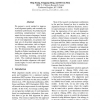Free Online Productivity Tools
i2Speak
i2Symbol
i2OCR
iTex2Img
iWeb2Print
iWeb2Shot
i2Type
iPdf2Split
iPdf2Merge
i2Bopomofo
i2Arabic
i2Style
i2Image
i2PDF
iLatex2Rtf
Sci2ools
ACL
2010
2010
Diversify and Combine: Improving Word Alignment for Machine Translation on Low-Resource Languages
We present a novel method to improve word alignment quality and eventually the translation performance by producing and combining complementary word alignments for low-resource languages. Instead of focusing on the improvement of a single set of word alignments, we generate multiple sets of diversified alignments based on different motivations, such as linguistic knowledge, morphology and heuristics. We demonstrate this approach on an English-to-Pashto translation task by combining the alignments obtained from syntactic reordering, stemming, and partial words. The combined alignment outperforms the baseline alignment, with significantly higher F-scores and better translation performance.
ACL 2010 | Complementary Word Alignments | Computational Linguistics | Translation Performance | Word Alignments |
| Added | 10 Feb 2011 |
| Updated | 10 Feb 2011 |
| Type | Journal |
| Year | 2010 |
| Where | ACL |
| Authors | Bing Xiang, Yonggang Deng, Bowen Zhou |
Comments (0)

